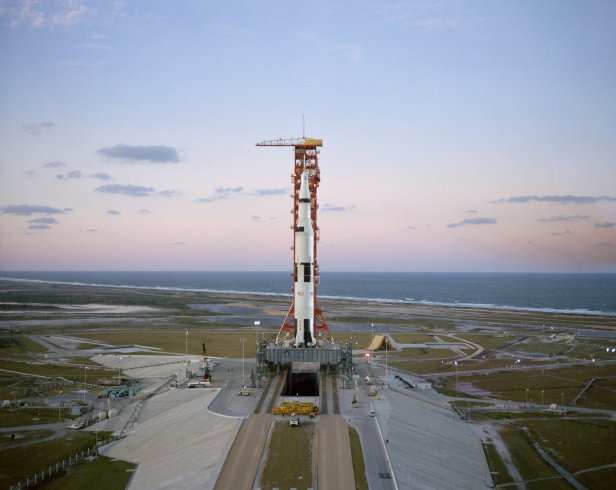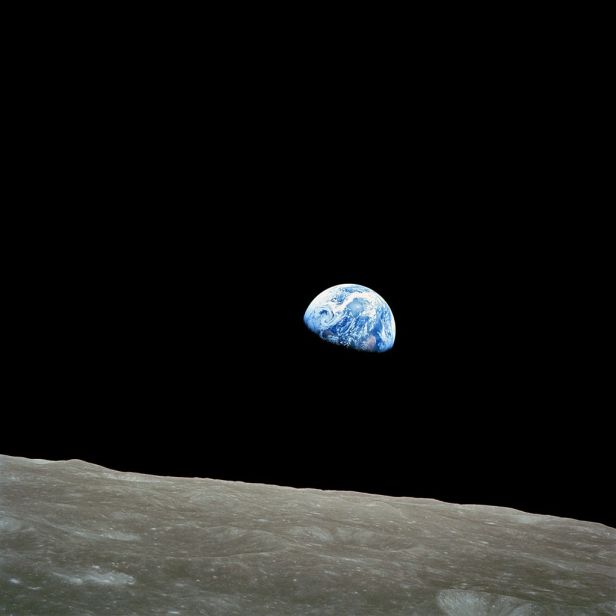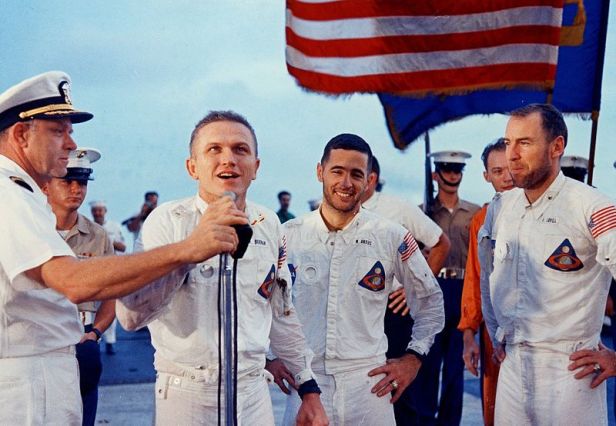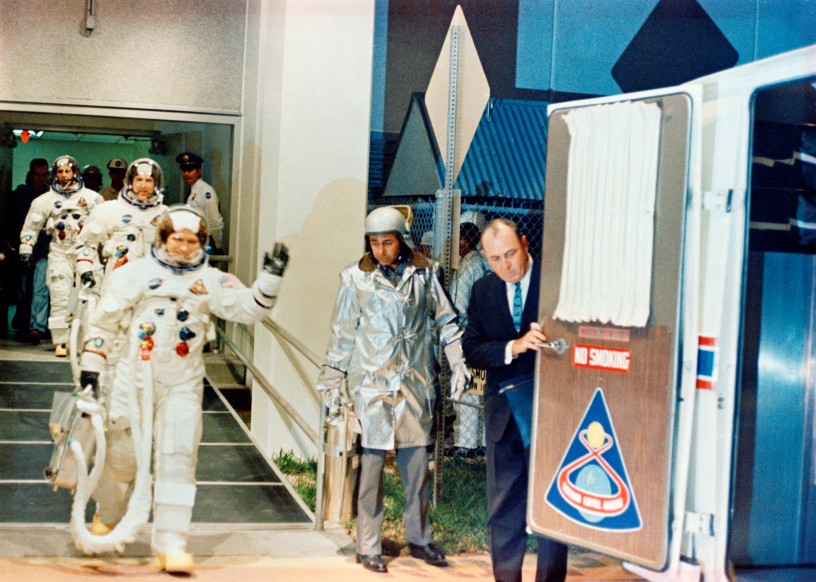Sometimes it can be easy to get so immersed in the detail of spaceflight, the documentation, the politics and the technical minutiae, that we lose sight of the very real emotional connection that our achievements can have.
Occasionally when things come together just right, for a brief moment we can all pull together and feel a collective human wonder at events we see unfolding. I suspect many of us have our own ‘special mission’, indeed one of the great pleasures of meeting fellow space enthusiasts is to swap stories of these pivotal moments, the wonder they gave us and the lasting glow that keeps us wanting to learn more. Increasingly these may be missions we only learn about decades after their completion – we come new to these experiences, yet they can affect us just as they affected the generation that witnessed them first-hand.
For me there will always be a special place in my heart for Apollo 8.
Apollo 8 was an improvised mission from the start. When NASA’s original plans had been devised the flights preceding the first landing were to be an orderly progression, deliberately ticking off the engineering and operational milestones until all of the skills had been practised bar the big one. But things don’t always work as planned and as NASA struggled to recover from the aftermath of the Apollo 1 fire and looked towards the Earth orbital shakedown cruise of Apollo 7, bold plans were afoot. Originally Jim McDivitt’s Apollo 8 crew were slated to test out the Lunar Module in Earth orbit, the D mission in Apollo planning parlance, but by mid 1968 it became apparent that the LM, still lagging behind schedule and overweight, would not be ready to fly until 1969.
Events on the other side of the iron curtain also had NASA management concerned. The Soviet Zond programme appeared to be gathering pace and it was clear that robotic missions during 1967 and early 1968 were a precursor for a crewed circumlunar voyage. While CIA estimates correctly guessed that the Soviets were likely still many years away from being able to mount a lunar landing mission and that the Zond craft would only be capable of looping around the Moon before returning to Earth, the likely propaganda impact such a flight would have was not lost on the decision makers in Washington and Houston with memories of Sputnik and Gagarin all too fresh in their minds. Although intelligence estimates through 1968 suggested that the chances of cosmonauts journeying to the Moon before the end of the year were becoming increasingly slim, they weren’t discounted completely.
Against this background George Low, the mild-mannered manager of the Apollo Spacecraft Program Office started to wonder. Assuming things went well for Wally Schirra’s Apollo 7 crew on their ‘C mission’ shakedown of the CSM, there seemed little point in a second orbital flight for the CSM to cover the same ground. A delay while waiting for the LM to become flight ready would have risked losing Apollo’s momentum so soon after a return to flight at a time when congress and the public were becoming less enamoured with the promise of spaceflight.
As early as the spring of 1968, Low had already discussed the possibility of sending the E mission (nominally planned for Apollo 9) to check out the LM in lunar orbit rather than high Earth orbit with Chris Kraft, Director of Flight Operations. Having received positive indications from Frank Borman that North American Aviation were making good progress on the redesigned Block II Command Module, Low now began to think in a slightly different direction. With the LM unavailable until 1969 there seemed little choice but to postpone the D mission, but what if a new step was put into the chain in the meantime? Could Apollo 8’s mission now become a circumlunar checkout of the CSM? It began to make a lot of sense to Low, after all the vehicle and support systems needed to be tested in deep space and, following the near disastrous Apollo 6 test flight, von Braun’s team now felt confident that they had shaken the problems out of the Saturn V.
The speed with which the revised plan for Apollo 8 came together was breathtaking. Low, having returned from a vacation on August 5th, began to set the wheels in motion, checking the plan’s feasibility with a select band of program managers. By August 9th a meeting had been convened for all of the Apollo senior management where the new mission received a ‘guardedly positive’ reaction. Apollo 8 would now become the C Prime (or C’) mission. Jim McDivitt, with months of training behind his crew and the chance to conduct the first flight of the LM, elected to remain with the D mission. On August 10th, Frank Borman was contacted by Deke Slayton and offered the chance to move his crew to the C’ mission. Borman, Lovell and Anders would now be the crew of Apollo 8 and in a few short months they would become the first humans ever to leave Earth orbit and journey to another world.
During late October 1968, Wally Schirra and his crew successfully flew Apollo 7, the C mission. In the immediate aftermath a growing groundswell of rumour hinted that Apollo 8 would be heading for the Moon and this was finally confirmed on November 12th by acting NASA Administrator Tom Paine. The mission would launch on December 21st 1968 and, rather than performing a simple loop around the Moon as the Soviets were doing with their Zonds, Apollo 8 would be going into lunar orbit.
It is incredible to consider that the decision making process to make this happen took little more than a week. All the more amazing to consider that all of the flight planning, vehicle preparation, crew training and a thousand other considerations could be managed in a little over 4 months. Apollo 8 would be the first crewed mission to ride the Saturn V, its astronauts would be first to leave Earth orbit, first to see the Moon from close quarters and, although it may not have been top of anyone’s priority at the time, first to look back and allow human eyes to see the Earth floating alone in the blackness of space. That the mission was to happen over Christmas only added to the magic of the mission, although to some this magnified their worries about the risks involved. If something should go wrong with the Service Propulsion System engine preventing the Trans Earth Injection burn from occurring, 3 American astronauts would spend weeks stranded in lunar orbit before expiring and surely taking with them any hope of a lunar landing before the decade was out.

View of the Apollo 8 Saturn V on the pad [IMG: NASA]
As it was Apollo 8 ran smoothly. The launch went well, with the Saturn V exhibiting none of the pogo problems that had almost caused calamity during Apollo 6. After two orbits of the Earth it was time to issue the command for the Trans Lunar Injection burn. Capcom for the initial stages of the flight was Mike Collins who had originally been part of Borman’s crew. But for a bone spur and resultant surgery, he could have been in the Command Module, but instead he sat at a console in Houston calmly issuing the order “Apollo 8, you are GO for TLI”.
The trip to the Moon was relatively uneventful, given that the three men were moving faster than any human ever had and moving further from the safety of Earth with every second. Borman caused some alarm when he was unwell, raising concern that his illness may be linked to the vehicle’s transit through the Earth’s radiation belts, but his condition soon improved. On Christmas Eve as Apollo 8 prepared to loop behind the Moon it was time for the next milestone event, Lunar Orbit Insertion. The burn itself would take place as the craft skimmed behind the Moon, meaning for the controllers back in Houston there was nothing to do except wait nervously and watch for the telemetry to reappear either sooner, in which case the burn had not functioned correctly and Apollo 8 was heading earthward, or later meaning the burn had been successful and Borman’s crew were safely in orbit. The final message prior to Loss of Signal came from Bill Anders “Thanks a lot troops, we’ll see you on the other side” then Apollo 8 slipped beyond the reach of earthbound communications. As Houston sweated it out, Borman, Lovell and Anders became the first humans to see the far side of the Moon, but they had little time to appreciate the spectacle on this first transit. Fortunately the LOI burn went off exactly as planned and, right on cue, Apollo 8 re-appeared from behind the Moon, safely in orbit.
“The Moon is essentially gray, no color. Looks like plaster of Paris. Sort of grayish sand…” These words from Jim Lovell were the first close-up description of the lunar surface, the goal of so much effort during the preceding 8 years. Borman would later comment “My own impression is that it’s a vast, lonely, forbidding type of existence, a great expanse of nothing…It certainly would not appear to be a very inviting place to live or work.” While in orbit the astronauts busied themselves with a variety of tasks such as photo reconnaissance of the surface including a close look at the proposed first landing site on the Sea of Tranquility. There was also much to do to prepare for the all important Trans Earth Injection burn, but even with the tight mission timeline there was still opportunity for the more human aspects of the adventure to assert themselves.
Two events really came to characterise Apollo 8. As the craft swung from behind the Moon for a fourth time Bill Anders captured one of the most famous and iconic images of human exploration – the Earth rising above the lunar surface. Within the tightly choreographed photo plan nobody had really considered trying to capture an ‘Earthrise’, or the profound impact it would have, firstly on the astronauts and later on the population of that blue oasis hanging in the emptiness of space. The second event for which the mission will always be remembered had been planned in advance by the crew. During their telecast on Christmas Eve, each of the astronauts gave their impressions of the Moon, their newfound unique perspective on the Earth. To finish the broadcast they took turns reading a passage from Genesis which Borman concluded by adding “…Good night, Good luck, a Merry Christmas and God bless all of you, all of you on the good earth.” His comment seemed to perfectly catch the mood and the moment, communicating a sentiment that went far beyond the technical achievements of the mission. The Moon would never seem quite the same again now that we had been there.

Apollo 8 had been an unqualified success. After the tragedy of Apollo 1 and the long road back to flight it once again seemed like America was on track to keep Kennedy’s promise. As Andrew Chaikin would conclude in his book A Man On The Moon “Apollo 8 was more than a successful space mission; it was a bright moment for a nation experiencing its first pangs of self-doubt”. The risks involved in Low’s grand improvisation had been considerable. For Jim Lovell, these became all too apparent during his next mission, Apollo 13. Had the same malfunction befallen the crew of Apollo 8, there would have been no way back, no LM lifeboat and no happy ending. The boldness and speed of the decision making that Apollo 8 characterised speaks to a different attitude to risk during the early years of space exploration. It is doubtful that such a mission would ever be considered now in the more risk-averse world we inhabit. Some may view the decision to go to the Moon with Apollo 8 as reckless, but personally I prefer to look at it as the kind of boldness required of humanity to make significant steps. Sometimes great risks are required to access the greatest rewards and sometimes that means loss and tragedy will be encountered as they were for Apollo, but the alternative, the easier option is simply not to try at all. Apollo 8 was a demonstration that by pushing against the safe option great accomplishments can be made, and new knowledge or a new way of looking at our situation can be found.
The perspectives gained during that week in 1968 still act to inspire new generations and the intangible magic of the crew’s images and Christmas message still ring a chord. For me these feelings were captured perfectly by the band Public Service Broadcasting on their recent concept album The Race for Space. Their track The Other Side uses the mission audio to convey the tension and relief of those moments. Possibly the music may not be to everyone’s taste, but the connection of the event carried in the words remains as striking as it ever was. I’ll leave the final words on this to the mission’s commander, Frank Borman:
“Exploration really is the essence of the human spirit, and to pause, to falter, to turn our back on the quest for knowledge is to perish.”

Sources
A Man On The Moon: The voyages of the Apollo astronauts – Andrew Chaikin
Apollo: The Race to the Moon – Charles Murray and Catherine Bly Cox
Apollo 8: A most Fantastic Voyage – Gen. Sam C. Phillips (National Geographic Vol. 135, No. 5 – May 1969)
Special thanks to Stephen Proctor for suggesting the title for this article


Just 21 letters to give one of the most momentous instructions of all time. ‘Apollo 8, you are go for TLI’
LikeLiked by 1 person
Thank you for this fantastic blogpost! Apollo 8 was an unbelievable mission! They travelled to the moon, but discovered the Earth!
This NASA video shows, how the astronauts saw the first time the earth:
Galactic greetings from Germany and Merry Christmas!
LikeLiked by 1 person
Thanks so much for sharing that, and a Merry Christmas to you too!
LikeLiked by 1 person
A wonderful blog capturing the mood from 50 years ago as if it were today.
Thank you for sharing.
LikeLike